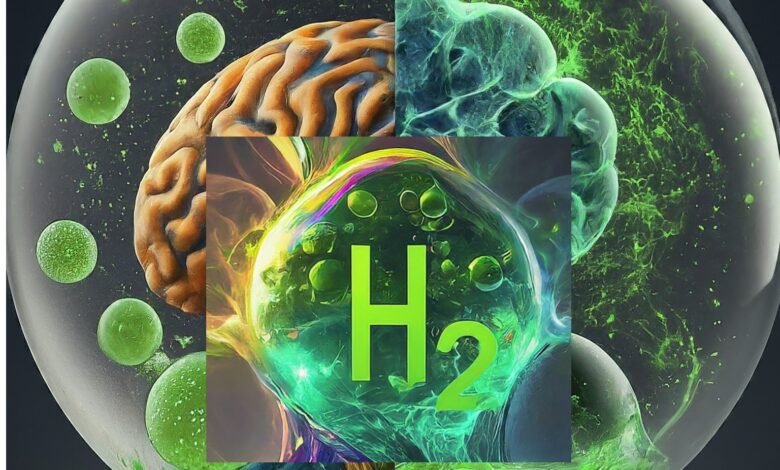AI Sparks Green Revolution: Affordable Electrodes Power the Future of Hydrogen
Introduction:- Green Hydrogen
Green Hydrogen, The world is facing a critical challenge: transitioning to clean energy sources to combat climate change. Green hydrogen, produced by splitting water using renewable electricity, emerges as a promising contender. However, its large-scale adoption hinges on one crucial factor – affordable and efficient electrode materials for water electrolyzers. Here’s where a recent breakthrough involving Artificial Intelligence (AI) offers a glimmer of hope.

Green Hydrogen: Powering a Sustainable Future
Green hydrogen refers to hydrogen produced through electrolysis, a process where electricity separates water molecules into hydrogen and oxygen. When the electricity used in this process comes from renewable sources like solar or wind power, the resulting hydrogen is considered “green.”
Green hydrogen holds immense potential as a clean energy carrier. It can be used in various applications, including:
Fuel Cells: Powering electric vehicles with zero tailpipe emissions.
Industrial Processes: Replacing fossil fuels in sectors like steel and ammonia production.
Energy Storage: Storing excess renewable energy for later use.
The Hurdle: Expensive Electrode Materials
Despite its potential, widespread adoption of green hydrogen faces a significant obstacle – the high cost of water electrolyzers. A crucial component of these electrolyzers is the electrodes, which facilitate the electrolysis process. Currently, the most efficient electrodes rely on platinum-group elements (PGEs).
However, PGEs are rare, expensive, and uneconomical for large-scale hydrogen production. Therefore, developing affordable and efficient alternative electrode materials is critical for making green hydrogen a commercially viable clean energy source.
Enter AI: Unveiling a New Path
A research team at the National Institute for Materials Science (NIMS) in Japan has leveraged the power of Artificial Intelligence to address this challenge. Their research, published in a leading scientific journal, details the development of an AI technique that accelerates the discovery of promising electrode materials.
The Power of AI-driven Material Discovery
Traditional material discovery often relies on a trial-and-error approach, which can be time-consuming and resource-intensive. AI offers a faster and more efficient alternative. This research team’s AI technique works in two stages:
Stage 1: Predicting material properties: The AI model is trained on a vast dataset of existing materials and their properties. This allows it to predict the properties of new, untested materials based on their chemical composition.
Stage 2: Identifying promising candidates: Based on the predicted properties, the AI identifies materials that exhibit characteristics ideal for efficient water electrolyzers, such as high conductivity and stability.
Unveiling New Possibilities: Affordable and Efficient Electrodes
By employing this AI technique, the NIMS team successfully identified several promising electrode materials free of PGEs. These materials utilize readily available and **affordable elements** like manganese (Mn), iron (Fe), nickel (Ni), zinc (Zn), and silver (Ag).
Testing and Performance:
The newly discovered materials were then synthesized and tested in water electrolyzers. The results were encouraging. These **PGM-free electrodes** demonstrated good performance, comparable to some existing PGE-based materials, while significantly reducing costs.
The Significance of this Breakthrough
This research using AI for material discovery holds several significant implications for the future of green hydrogen:
Reduced Production Costs: Affordable electrode materials will significantly lower the cost of water electrolyzers, making green hydrogen production more economically viable.
Faster Development: AI can accelerate the discovery and development of even better electrode materials, further improving efficiency and reducing costs.
Sustainability: Replacing PGEs with abundant elements promotes a more sustainable approach to green hydrogen production.
Beyond Green Hydrogen: Broader Applications
The potential applications of this AI technique extend beyond green hydrogen. It can be used to discover new materials for various clean energy technologies, including:
Solar Cells: Developing more efficient and cost-effective materials for solar energy conversion.
Batteries: Exploring new battery materials with higher capacity and faster charging times.
Fuel Cells: Identifying materials that improve the performance and durability of fuel cells in electric vehicles.
The Road Ahead: Refining the Technique and Global Collaboration
While this research marks a significant step forward, further development is needed:
Refining the AI Model: As more data becomes available, the AI model can be continuously improved, leading to even more accurate predictions and efficient material discovery.
Experimental Validation: The newly discovered materials require further testing and optimization for long-term stability and performance in real-world applications.
Global Collaboration: International collaboration between researchers and industries can accelerate progress in AI-driven material discovery for clean energy technologies.
Conclusion: A Brighter Future for Clean Energy
The use of AI to discover affordable electrode materials for green hydrogen production is a game-changer
The use of AI to discover affordable electrode materials for green hydrogen production is a game-changer. It paves the way for a more sustainable and cost-effective approach to clean energy. This breakthrough, coupled with continued research and collaboration, holds immense promise for powering a greener future.
Looking Forward: A Glimpse into the Future
Imagine a world where:
Green hydrogen is a readily available and affordable energy source, powering homes, industries, and transportation with zero emissions.
Renewable energy sources like solar and wind power are seamlessly integrated with efficient green hydrogen production and storage systems.
AI plays a pivotal role in accelerating the discovery of new materials for various clean energy technologies, leading to a cleaner and more sustainable future for all.
This future is not a distant utopia. The research on AI-driven material discovery brings us closer to this vision. With continued investment in research, development, and global collaboration, we can harness the power of AI to unlock a new era of clean energy.
Additional Sections to Consider
Case Studies: Success Stories of AI in Clean Energy
Highlight other examples of how AI is being used to develop clean energy technologies.
Showcase successful applications in areas like solar cell optimization or battery design.
The Ethical Considerations:
Briefly discuss potential ethical considerations surrounding the rapid development of new materials, such as potential environmental impacts or responsible sourcing of resources.
By incorporating these sections, you can create a comprehensive and informative article that explores the significance of AI in green hydrogen production and its broader implications for the future of clean energy.




